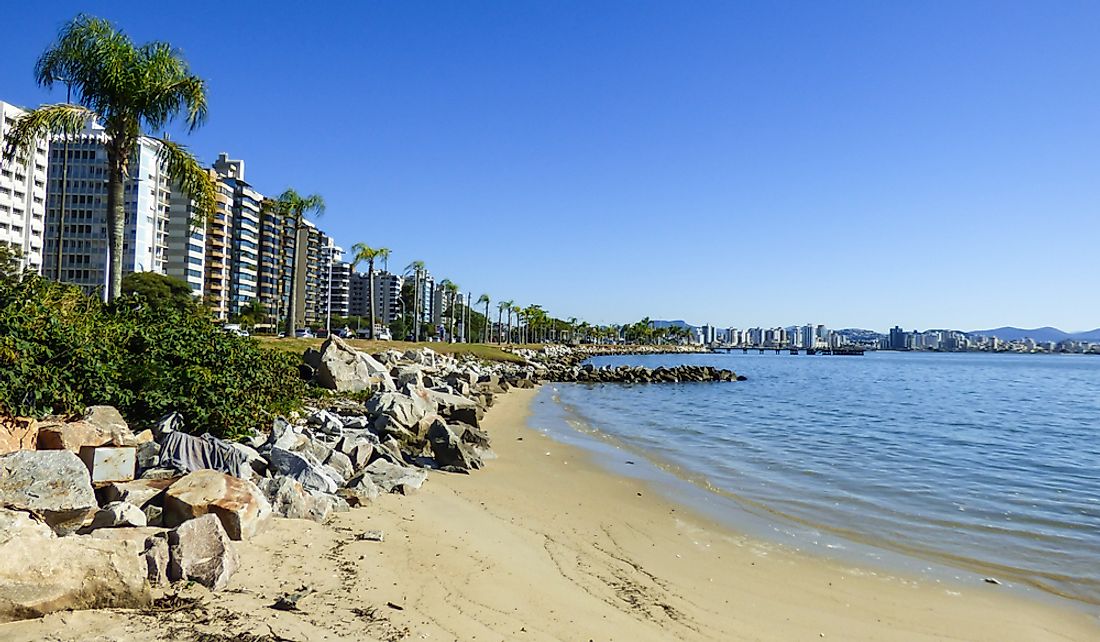Florianópolis - Capital Of The Santa Catarina State Of Brazil

Santa Catarina is a state in the southern region of Brazil. With an area of 95,346 km2 and an estimated population of 6.7 million, Santa Catarina is the 20th most extensive state in Brazil and the 11th most populous. The eastern edge of Santa Catarina has a coastline along the Atlantic Ocean, while the western part of the state shares an international border with Argentinian province of Misiones. The state's landscape features several lagoons, inlets, bays, and islands, and the beaches of Santa Catarina attract many tourists. The Serra do Mar coastal forests are a tropical ecoregion, while the central part of the state includes Araucaria moist forests. Several rivers also flow through the state, such as the Paraná River and the Uruguay River. Florianópolis is the state capital of Santa Catarina.
Capital of Santa Catarina: Florianópolis
Florianópolis has an area of approximately 675.4 km2 and is situated at an average elevation of 3 m above sea level. The city consists of Santa Catarina Island, small nearby islands in the Atlantic Ocean, and small a part of the mainland. Florianópolis is regarded as one of the safest cities in Brazil and has the third highest Human Development Index (HDI) score of all cities in the country. The city is served by Hercílio Luz International Airport, experiences a warm humid subtropical climate, and contains a native Atlantic Forest-type vegetation.
Demographics of Florianópolis
Florianópolis has an estimated population of 477,798 individuals, ranking as the second most populous city in Santa Catarina. The city's population includes the following population groups: White/Caucasian (90%); Pardo or mixed-race (9%); Black (1%) and Asian and indigenous populations (0.1%). Florianópolis is considered cosmopolitan, but its colonial period is reflected in its architecture and the dialects or languages spoken in the city.
History of Florianópolis
The Florianópolis area was historically inhabited by the Tupi people and other indigenous tribes. Portuguese colonists landed in the area in approximately 1514 and named it Ilha dos Patos, but later renamed it Saint Catherine Island in 1526. The formal colonial settlement on the island developed in response to the arrival of a Portuguese agricultural company in 1673. In 1678, a chapel was established on the island, and in 1714 the settlement was upgraded to the status of a village and named Nossa Senhora do Desterro, which reflected its Portuguese identity. The settlement grew quickly and was upgraded to a town in 1726. Migrants from the Azores arrived on the island in great numbers between 1747 and 1756, and agriculture and industry experienced rapid growth during the 18th century. In 1889, Desterro was named the capital of Santa Catarina, and in 1893 Desterro was renamed as Florianópolis, after then president of Brazil, Marechal Floriano Peixoto.
Economy of Florianópolis
The economy of Florianópolis is largely driven by commerce and the service sector. Tourism is also one of the city’s biggest industries, as visitors are attracted to its Azorean culture, which is reflected in the architecture, cuisine, folklore, and religious traditions of Florianópolis. The city also contains some of Brazil's top-performing universities and colleges, and nearly 97% of the population is literate. Florianópolis has a well-developed transport network, and software and technology development firms in the city have experienced rapid growth in the past few decades.











